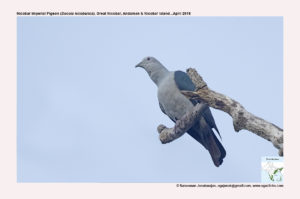Nicobar Imperial Pigeon

Nicobar Imperial Pigeon Ducula aenea nicobarica
Etymology:
- Ducula : Latin word for “Imperial , Duke”
- Aenea: Latin word aeneusof a bronze colour derived from aeris – bronze
- Nicobarica: From Nicobar islands , India
Distribution in India: Resident of Andaman & Nicobar in India.
Description Size of 43-47 cm. The head, neck, upper mantle, breast and belly pale grey-pink; some white feathers around eye and at base of bill; upper parts iridescent green, with bluish or bronze tinge; primaries, outer secondaries and tail feathers grey with slight green or blackish green iridescence; under tail-coverts dark chestnut; iris dark brown to red with lilac outer ring and crimson orbital sin; bill bluish grey with red or purplish cere; legs and feet dark pinkish red or purple-red. Both sexes are alike, but female often slightly duller. The races sylvaticavary extensively in coloration: race andamanica has slightly more white around face and darker vent than previous two races; race nicobarica has dark, almost blackish iridescent green upperparts, grey head, neck and underparts without any pink tinge, and dusky-brown vent.
Habitat: It is found in forests, including both primary and secondary evergreen and monsoon forests; also coastal scrub, coconut groves, mixed gardens, mangroves, palm swamps, open country with scattered trees, savanna woodland and second growth
Food Habits: It is frugivorous, taking a large variety of fruits and berries. It feeds in the upper canopy. It regularly descends to ground to drink water or to take salt-rich soil.
Breeding Habits: They breed in Mar- Jun in Andaman & Nicobar. The male performs spectacular display-flight, commencing in normal flight, then suddenly beats wings vigorously and shoots vertically upwards, then stalls momentarily with wings flexed and neck outstretched, as if about to tip over backwards, before finally turning sharply and diving down, then resuming normal flight, or rises from trees to perform similar flight. The nest is a slight platform of loosely arranged twigs, placed in a leafy sapling or understorey tree; both sexes take part in nest building. They lay a clutch of one egg. Incubation is by both sexes.